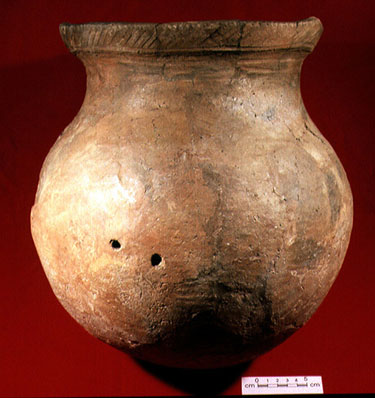
Exhibit Specimen 19
(CMCC BaGg-2:1)
 This vessel is decorated in a style known as Middleport Oblique. It was found among wind-eroded sand banks by James F. Pendergast near Picton, Ontario in 1951. Similar containers have been found throughout Southern Ontario dating to between the late XIIIth century and the end of the XIVth century during what is known as the Middle Iroquois Period. It is characterized by a poorly defined collar decorated with parallel oblique incisions. This band of obliques is then followed by a series of parallel, horizontal lines extending down onto the neck of the vessel. The vessel body is globular and retains faint checked paddle impression. Two repair holes are visible and were used to allow some sort of cordage to bind together a crack which had developed.
This vessel is decorated in a style known as Middleport Oblique. It was found among wind-eroded sand banks by James F. Pendergast near Picton, Ontario in 1951. Similar containers have been found throughout Southern Ontario dating to between the late XIIIth century and the end of the XIVth century during what is known as the Middle Iroquois Period. It is characterized by a poorly defined collar decorated with parallel oblique incisions. This band of obliques is then followed by a series of parallel, horizontal lines extending down onto the neck of the vessel. The vessel body is globular and retains faint checked paddle impression. Two repair holes are visible and were used to allow some sort of cordage to bind together a crack which had developed.
The Middle Iroquois Period in southern Ontario led directly to the Late Iroquois Period out of which the well-known historic period Iroquoian groups emerged. These included the Huron, Petun and Neutral.
Further Reading
Dodd, C.F., D.R. Poulton, P.A. Lennox, D.G. Smith and G.A. Warrick
1990 The Middle Ontario Iroquoian Stage. In The Archaeology of Southern Ontario to A.D. 1650, edited by C.J. Ellis and N. Ferris. Occasional Publication of the London Chapter, OAS No.5, London, Ontario.
Wintemberg, W.J.
1948 The Middleport Prehistoric Village Site. National Museum of Canada Bulletin No.109. Department of Mines and Resources, Ottawa.
Wright, J.V.
1973 The Ontario Iroquois Tradition. National Museum of Canada Bulletin 210. National Museums of Man, Ottawa.
Next
Previous
Back to the beginning